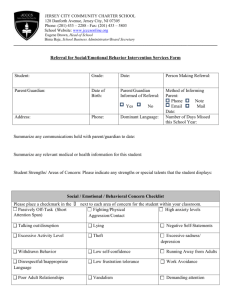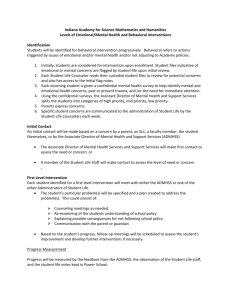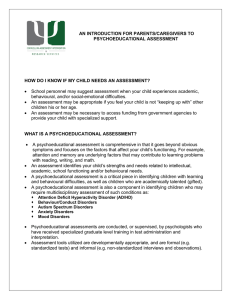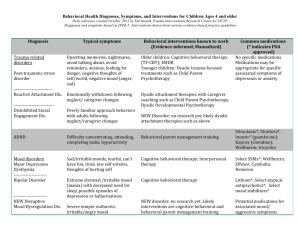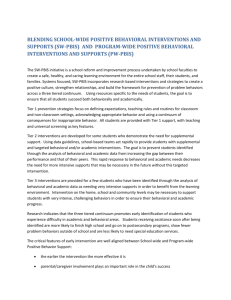EdS Case Study Guidelines
advertisement
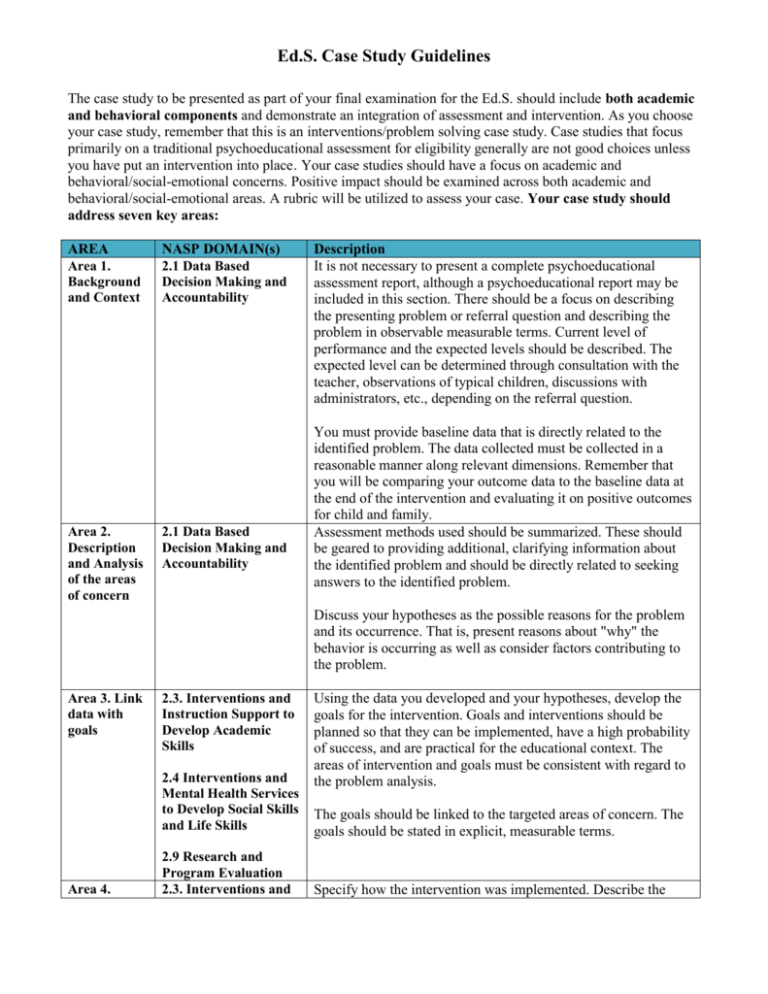
Ed.S. Case Study Guidelines The case study to be presented as part of your final examination for the Ed.S. should include both academic and behavioral components and demonstrate an integration of assessment and intervention. As you choose your case study, remember that this is an interventions/problem solving case study. Case studies that focus primarily on a traditional psychoeducational assessment for eligibility generally are not good choices unless you have put an intervention into place. Your case studies should have a focus on academic and behavioral/social-emotional concerns. Positive impact should be examined across both academic and behavioral/social-emotional areas. A rubric will be utilized to assess your case. Your case study should address seven key areas: AREA Area 1. Background and Context Area 2. Description and Analysis of the areas of concern NASP DOMAIN(s) 2.1 Data Based Decision Making and Accountability 2.1 Data Based Decision Making and Accountability Description It is not necessary to present a complete psychoeducational assessment report, although a psychoeducational report may be included in this section. There should be a focus on describing the presenting problem or referral question and describing the problem in observable measurable terms. Current level of performance and the expected levels should be described. The expected level can be determined through consultation with the teacher, observations of typical children, discussions with administrators, etc., depending on the referral question. You must provide baseline data that is directly related to the identified problem. The data collected must be collected in a reasonable manner along relevant dimensions. Remember that you will be comparing your outcome data to the baseline data at the end of the intervention and evaluating it on positive outcomes for child and family. Assessment methods used should be summarized. These should be geared to providing additional, clarifying information about the identified problem and should be directly related to seeking answers to the identified problem. Discuss your hypotheses as the possible reasons for the problem and its occurrence. That is, present reasons about "why" the behavior is occurring as well as consider factors contributing to the problem. Area 3. Link data with goals 2.3. Interventions and Instruction Support to Develop Academic Skills 2.4 Interventions and Mental Health Services to Develop Social Skills and Life Skills Area 4. 2.9 Research and Program Evaluation 2.3. Interventions and Using the data you developed and your hypotheses, develop the goals for the intervention. Goals and interventions should be planned so that they can be implemented, have a high probability of success, and are practical for the educational context. The areas of intervention and goals must be consistent with regard to the problem analysis. The goals should be linked to the targeted areas of concern. The goals should be stated in explicit, measurable terms. Specify how the intervention was implemented. Describe the Ed.S. Case Study Guidelines Specific Description of the Intervention Instruction Support to Develop Academic Skills 2.4 Interventions and Mental Health Services to Develop Social Skills and Life Skills intervention related to each specific goal. Components of the intervention must be explained in sufficient detail that the reader would be able to put a similar intervention in place. The intervention steps must be manageable and realistic given the available resources. A description of how the intervention is being monitored also should be included. The intervention can be direct or indirect. 2.8 Diversity and Development in Learning 2.9 Research and Program Evaluation 2.10 Legal, Ethical, and Professional Practice Area 5. 2.2 Consultation and Collaborative Collaboration efforts 2.7 Family-School Collaboration Services Area 6. Outcome Data 2.1 Data Based Decision Making and Accountability 2.9 Research and Program Evaluation Area 7. Positive Impact on Families and Children 2.1 Data-Based Decision Making and Accountability 2.10 Legal, Ethical, and Professional Practice Describe how relevant members of the client(s)' environment were included in the case at the various points; e.g., any collaborative activities from Areas 1-4. Describe the role of each participant and what supports were in place for the participants. If attempts at collaboration were partially successful or unsuccessful, there should be an explanation of the attempts made and the potential effects. Data should be provided to illustrate the success of the intervention in addressing each goal. Data should be provided directly related to the change in behavior or skills by comparing the baseline data or assessment data with the outcome data. Data should be transformed from raw forms to allow determination of change. Progress towards meeting goals should also be discussed. Describe the progress, how it was monitored, factors that may have impeded progress, possible modifications and whether the problem has been solved or requires further or different intervention. Even if interventions were focused on academic or behavior/social-emotional, discussion should occur on overall positive impact on the family and child and utilize data and anecdotal information to evaluate.
